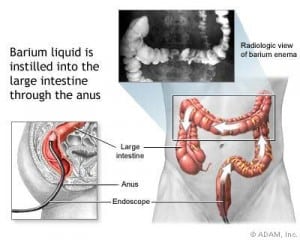What is a barium enema?
A Barium Enema is a special x-ray used to to help diagnose problems of the large intestine which includes the colon and rectum often known as a lower GI series.
A lower GI series is sometimes called a barium enema x-ray because the large intestine is filled with barium liquid. The barium liquid coats the lining of the large intestine and clearly displays any signs of disease on the x-ray.
What problems can a barium enema or Lower GI series detect?
A barium enema/lower GI series can detect problems of the large intestine, including:
- polyps
- diverticula—bulges in the intestinal
- wall cancerous growths
- ulcers
- fistulae—abnormal openings in the intestinal wall that lead to the abdominal cavity, other organs, or the skin’s surface
- inflammation
When is a barium enema or Lower GI series used?
A lower GI series can be used to help determine the cause of: chronic diarrhea, rectal bleeding, abdominal pain, changes in bowel habits, and unexplained weight loss.
How to Prepare for a barium enema or Lower GI series
To prepare for a lower GI series, patients must empty all solids from the GI tract during a “bowel prep,” which is usually done at home. The doctor provides written bowel prep instructions. Generally, patients follow a clear liquid diet for 1 to 3 days before the procedure. Acceptable liquids include:
- fat-free bouillon or broth strained fruit juice water
- plain coffee or plain tea
- sports drinks, such as Gatorade or gelatin
A laxative or enema is usually used the evening before a lower GI series. A laxative is medicine that loosens stool and increases bowel movements. Laxatives are usually swallowed as a pill or as a powder dissolved in water. An enema involves flushing a liquid solution into the anus using a special squirt bottle. Enemas are sometimes repeated the morning of the test.
Sometimes, especially when only the rectum or end of the colon is being evaluated, emptying all solids from the entire GI tract beforehand is not necessary. Instead, the patient undergoes one or more enemas the day of the procedure to remove solids from just the large intestine.
Before starting the bowel prep, patients should tell their doctor about all health issues and medications. Women who may be pregnant should discuss getting an alternate test, such as colonoscopy, or taking precautions to minimize radiation exposure to their unborn child.
How is a barium enema or lower GI series test is performed?
A lower GI series is conducted by a radiology technologist or a radiologist—a doctor who specializes in x-ray imaging—at a hospital or outpatient center.
While the patient lies on an x‐ray table, a lubricated tube is inserted into the anus and the large intestine is filled with a barium liquid solution. Patients may experience some discomfort and will feel the urge to have a bowel movement. Leakage of barium liquid is prevented by an inflated balloon on the end of the tube. To evenly coat the inside of the large intestine with barium liquid, patients are asked to change positions several times.
X‐ray pictures and possibly x-‐ray videos are taken while the patient holds still in various positions, allowing the technologist or radiologist to see the large intestine at different angles. If a technologist conducts the lower GI series, a radiologist will later examine the images to look for problems.
When the imaging is complete, the balloon on the tube is deflated and most of the barium liquid drains through the tube. The patient expels the remaining barium liquid into a bed pan or nearby toilet. An enema may be used to flush out the remaining barium liquid. The entire procedure takes 30 to 60 minutes—longer if it includes a double contrast study.
What is a double contrast study?
The double contrast study gets its name from the combination of air and barium liquid working together to create a more detailed view of the intestinal lining on x rays. If performed, a double contrast study takes place after the patient has expelled most of the barium liquid. What remains clings to the intestinal wall. The large intestine is inflated with air, expanding the barium-‐coated large intestine, and additional x rays are taken.
Recovery from a Lower GI Series
For an hour or so after the procedure, most patients experience bloating. Not eating before the test and the test itself may cause one to feel tired. Repeated bowel movements and enemas during the bowel prep may cause anal soreness. And for several days, traces of barium liquid in the large intestine cause stools to be white or light colored. Unless otherwise directed, patients may immediately resume their normal diet.
Points to Remember
- A lower gastrointestinal (GI) series uses x-rays to help diagnose problems of the large intestine, which includes the colon and rectum.
- A lower GI series can detect polyps, diverticula, cancerous growths, and other problems. To prepare for a lower GI series, patients must empty all solids from the GI tract during a “bowel prep,” which is usually done at home.
- A lower GI series is performed by a radiology technologist or a radiologist at a hospital or outpatient center. During the procedure, the large intestine is filled with barium liquid and x-ray pictures and possibly x‐ray video are taken.
- After the procedure, patients may feel tired, bloated and/or may experience anal soreness from the bowel prep.
- Possible risks of a lower GI series include mild constipation, bowel obstruction, kidney injury, electrolyte imbalances, an allergic reaction to barium liquid, leakage of barium into the abdomen, and cell or tissue damage from radiation exposure.
Helpful Links


